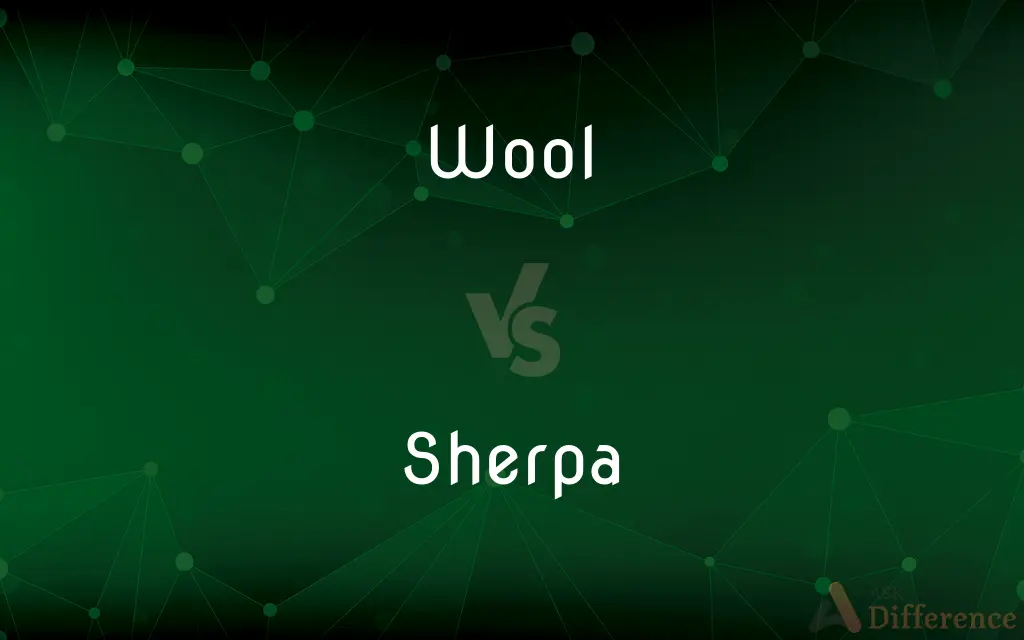Wool vs. Sherpa — What's the Difference?
Edited by Tayyaba Rehman — By Fiza Rafique — Updated on November 5, 2023
Wool is a natural fiber from animals like sheep; Sherpa is a fabric, often synthetic, mimicking wool's texture but lighter and less expensive.

Difference Between Wool and Sherpa
Table of Contents
ADVERTISEMENT
Key Differences
Wool is a natural fiber obtained from sheep and other animals, including goats (cashmere and mohair), rabbits (angora), and camels. It has been used for centuries in various forms of textiles due to its warmth, durability, and natural crimp, which gives it elasticity.
Sherpa, in the textile context, refers to a type of fabric made to resemble wool, particularly the bumpy texture of shearling. It is often synthetic, such as polyester, and designed to have a fluffy pile on one side. The name “Sherpa” comes from the Sherpa people of Nepal, known for their wool garments.
While wool is prized for its insulating properties and ability to regulate temperature and moisture, Sherpa is appreciated for its lightweight, easy care, and warmth relative to weight. Wool garments are often more durable and can last many years with proper care.
Sherpa fabric is generally easier to launder and maintain than wool, which may require special cleaning methods such as hand-washing or dry-cleaning. Sherpa is also less expensive, making it a popular lining for winter garments or as a wool alternative in budget-friendly clothing lines.
Although wool can be itchy or allergenic to some people, Sherpa's synthetic make-up usually offers a hypoallergenic and non-irritating alternative. However, wool's natural fibers offer environmental benefits over the petroleum-based fibers typically used in Sherpa fabric.
ADVERTISEMENT
Comparison Chart
Origin
Natural animal fiber.
Often synthetic, man-made material.
Texture
Can be coarse or fine, varied.
Designed to be fluffy and soft.
Warmth
Excellent insulator, warm.
Warm, but often less insulating than wool.
Care
May require special cleaning.
Usually machine washable and easier to maintain.
Cost
Generally more expensive.
Typically less costly than real wool.
Compare with Definitions
Wool
Textile material known for its warmth and used in clothing.
He wore a wool coat to stay warm in winter.
Sherpa
A fabric resembling sheepskin with a fleece-like side.
The Sherpa lining of the jacket was incredibly soft.
Wool
The hair of sheep, often spun into thread for weaving.
Farmers sheared the sheep to collect wool.
Sherpa
A term for plush, wool-like synthetic textiles.
She bought a Sherpa rug for her bedroom floor.
Wool
A natural insulating material often used in outerwear.
Wool mittens are perfect for cold weather.
Sherpa
A fabric known for its soft texture and lightweight warmth.
The baby's Sherpa blanket was both light and warm.
Wool
Wool is the textile fibre obtained from sheep and other animals, including cashmere and mohair from goats, qiviut from muskoxen, hide and fur clothing from bison, angora from rabbits, and other types of wool from camelids.Wool consists of protein together with a small percentage of lipids. In this regard it is chemically quite distinct from the more dominant textile, cotton, which is mainly cellulose.
Sherpa
A synthetic material imitating the look and feel of wool.
Her Sherpa throw blanket added warmth to the room.
Wool
The fine, soft curly or wavy hair forming the coat of a sheep, goat, or similar animal, especially when shorn and prepared for use in making cloth or yarn
Harris tweed is made from pure new wool
Sherpa
A pile fabric often used for warmth in apparel linings.
He preferred a Sherpa-lined hoodie for chilly evenings.
Wool
The dense, soft, often curly hair forming the coat of sheep and certain other mammals, such as the goat and alpaca, consisting of cylindrical strands of keratin covered by minute overlapping scales and much valued as a textile fiber.
Sherpa
A member of a Himalayan people living on the borders of Nepal and Tibet, renowned for their skill in mountaineering.
Wool
Fabric or yarn made of this hair.
Sherpa
A member of a traditionally Buddhist people of Tibetan ancestry living on the southern side of the Himalaya Mountains in Nepal and the Indian state of Sikkim. In modern times Sherpas have achieved renown as high-altitude porters and expert guides on Himalayan mountaineering expeditions.
Wool
Hairy or downy material on a plant or animal, as on certain caterpillars.
Sherpa
(countable) A local mountain guide or porter, particularly a male of the Nepalese Sherpa people so employed.
Wool
Filamentous or fibrous material similar to the wool of a sheep or other mammal.
Sherpa
(countable) An expert accompanying a high-ranking leader to a summit meeting.
Wool
The hair of the sheep, llama and some other ruminants.
Sherpa
A synthetic fabric with a long, thick pile, similar to faux fur, imitation lamb wool, or fleece.
Wool
A cloth or yarn made from the wool of sheep.
Sherpa
(rare) To serve as a guide or porter for another.
Wool
Anything with a texture like that of wool.
Sherpa
A member of the Himalayan people living in Nepal and Tibet who are famous for their skill as mountaineers
Wool
A fine fiber obtained from the leaves of certain trees, such as firs and pines.
Wool
(obsolete) Short, thick hair, especially when crisped or curled.
Wool
Yarn, including that made from synthetic fibers.
Wool
A resident of a satellite town outside Liverpool, such as St Helens or Warrington. See also Yonner.
Wool
The soft and curled, or crisped, species of hair which grows on sheep and some other animals, and which in fineness sometimes approaches to fur; - chiefly applied to the fleecy coat of the sheep, which constitutes a most essential material of clothing in all cold and temperate climates.
Wool
Short, thick hair, especially when crisped or curled.
Wool of bat and tongue of dog.
Wool
A sort of pubescence, or a clothing of dense, curling hairs on the surface of certain plants.
Wool
A fabric made from the hair of sheep
Wool
Fiber sheared from animals (such as sheep) and twisted into yarn for weaving
Wool
Outer coat of especially sheep and yaks
Wool
Fiber from the fleece of sheep or other animals.
Her grandmother knit a scarf from pure wool.
Wool
A yarn or fabric made from the soft hair of animals.
The wool sweater was soft and cozy.
Common Curiosities
Can Sherpa fabric be made of wool?
Sherpa can mimic wool but is usually made from synthetic fibers.
Is wool hypoallergenic?
Wool is not hypoallergenic and can cause irritation for some.
Is wool water-resistant?
Wool is naturally water-resistant to some degree.
Does Sherpa provide the same warmth as wool?
Sherpa is warm but generally does not match wool's insulating properties.
Is Sherpa easier to care for than wool?
Yes, Sherpa is usually machine washable and easier to maintain.
Are wool products environmentally friendly?
Wool is biodegradable and renewable, making it environmentally friendly.
Can Sherpa be considered eco-friendly?
Since it's often synthetic, it's less eco-friendly than natural wool.
Can wool be machine washed?
Some modern wools can be machine washed, but it often requires special care.
Does wool come in different grades?
Yes, wool is graded based on fineness and length.
Does wool shrink?
Wool can shrink if not washed according to care instructions.
Is Sherpa shrink-resistant?
Sherpa fabric tends to be shrink-resistant.
Is all wool itchy?
Not all wool is itchy; finer wools like merino are very soft.
Does Sherpa have a real fleece side?
Sherpa has one side that's fleece-like, but it's not real fleece.
Can people with wool allergies use Sherpa?
People with wool allergies can often use Sherpa without issues.
Is Sherpa suitable for outdoor clothing?
Sherpa is suitable for outdoor clothing, especially as lining for added warmth.
Share Your Discovery

Previous Comparison
Protomer vs. Oligomer
Next Comparison
Neighbor vs. NeighbourAuthor Spotlight
Written by
Fiza RafiqueFiza Rafique is a skilled content writer at AskDifference.com, where she meticulously refines and enhances written pieces. Drawing from her vast editorial expertise, Fiza ensures clarity, accuracy, and precision in every article. Passionate about language, she continually seeks to elevate the quality of content for readers worldwide.
Edited by
Tayyaba RehmanTayyaba Rehman is a distinguished writer, currently serving as a primary contributor to askdifference.com. As a researcher in semantics and etymology, Tayyaba's passion for the complexity of languages and their distinctions has found a perfect home on the platform. Tayyaba delves into the intricacies of language, distinguishing between commonly confused words and phrases, thereby providing clarity for readers worldwide.
















































